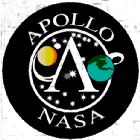 The Apollo Missions
The Apollo Missions The Apollo Missions
The Apollo Missions

Many people feel that the Apollo program stands as mankind's greatest technological achievement. In all, six missions landed on the surface of the moon, and three others orbited the moon without landing, including the ill-fated Apollo 13.
The spacecraft was in three parts: The conical Command Module where the crew ate and slept on its way to the moon and home; the Service Module, supplying electricity, maneuvering power and thrust to get home from lunar orbit, and water to the spacecraft; and the Lunar Module, or LM, a two-part, totally self-contained spacecraft that used its own rockets to land on and take off from the surface of the moon, and even served as its own launch pad.
Apollo missions were launched atop two different boosters, the Saturn 1B used for the Earth orbiting missions (including Apollo-Soyuz), and the mighty Saturn V, the rocket to the moon.
Apollo started in tragedy, when a fire on the launch pad in the Command Module of Apollo 1 claimed the lives of our second man in space and first Gemini astronaut,Virgil I. "Gus" Grissom, our first space walker, Edward White, and rookie astronaut Roger Chaffee on January 27, 1967, in a routine training exercise for what had been scheduled to be the first Apollo mission.
Although the spacecraft had to be modified to prevent any chance of a recurrance, was readied for flight by October, 1968, after an unoccupied test (named Apollo 4, the first flight of the Saturn V). Following its success, Apollo 8, the first human flight of the Saturn V, was launched around the moon in December, and by the following July, Apollo 11 actually placed a man on another celestial body and brought him home again.
Twelve men in all walked on the moon before Apollo was done. The last three missions featured the Lunar Rover, which permitted the astronauts to drive about and explore various terrains too rough for the LM to attempt to land upon. On the last Apollo mission to the moon, the astronauts spent 22 hours in moon walks and camped out on the moon for three days total.
Sadly, Apollo 18, 19 and 20 were cancelled due to budget limitations. One of these missions had been scheduled to explore the scientifically intriguing crater Aristarchus, where astronomers through the ages had witnessed geological (or, more properly, "lunalogical") activity through their telescopes and wondered whether or not it might be volcanism. We are still wondering.
We have never yet returned to the moon. How sad. The Apollo spacecraft was used for four later missions, the three long-duration missions and the final Apollo flight, the Apollo-Soyuz linkup with the Soviet Soyuz 19.

Mission Astronauts Launch/Landing1/Landing2 Highlights
Walter M. Schirra, Jr. October 11, 1968 First Apollo mission
Apollo 7 Donn F. Eisele October 22, 1968 to fly. Made 163
Walter Cunningham orbits of earth. Frank Borman December 21, 1968 First occupied launch of
Apollo 8 James A. Lovell, Jr. December 27, 1968 Saturn V. Looped around
William A. Anders moon on Christmas Eve. James A. McDivitt March 3, 1969 151 orbits of Earth.
Apollo 9 David R. Scott March 13, 1969 First human test of
Russell R. Schweikart Lunar Module. Thomas P. Stafford May 18, 1969 Orbited moon. Lunar
Apollo 10 John W. Young May 26, 1969 Module dropped to within
Eugene A. Cernan 9 miles of Lunar surface. Neil A. Armstrong July 16, 1969 Landed on moon with 30 seconds
Apollo 11 Michael Collins July 20, 1969 of fuel remaining. Took core
Edwin E. "Buzz" Aldrin July 24, 1969 samples. Planted American flag. Charles "Pete" Conrad November 14, 1969 Met up with and returned
Apollo 12 Richard F. Gordon, Jr. November 18, 1969 parts of old
Alan L. Bean November 24, 1969 Surveyor 3 probe. James A. Lovell, Jr. April 11, 1970 "OK, Houston, we've had a
Apollo 13 Fred W. Haise, Jr. April 17, 1970 problem here." O2 tank blew up;
John L. Sweigert. Jr. LM got 'em around moon and home. Alan B. Shepard, Jr. January 31, 1971 Extensive scientific experiments.
Apollo 14 Stuart A. Roosa February 3, 1971 Astronauts almost got lost when
Edgar D. Mitchell February 9, 1971 alien landscape became disorienting. David R. Scott July 26, 1971 First use of Lunar Rover.
Apollo 15 James B. Irwin July 30, 1971 Astronauts rode over 27 kilometers.
Alfred M. Worden August 7, 1971 First Apollo space walk. John W. Young April 16, 1972 Malfunction almost scrubbed landing.
Apollo 16 Thomas K. Mattingly II April 20, 1972 Stayed 3 days, got Lunar Rover up
Charles M. Duke, Jr. April 27, 1972 to almost 18 kph. Eugene A. Cernan December 7, 1972
Apollo 17 Ronald E. Evans December 11, 1972 Last men on the moon (so far).
Harrison H. Schmitt December 19, 1972

Mission Astronauts Launch/Landing Orbits Duration
Charles "Pete" Conrad May 25, 1973
Skylab I Paul J. Weitz June 22, 1973 404 672 hours, 49 minutes, 49 seconds
Joseph P. Kerwin Alan L. Bean July 28, 1973
Skylab II Jack R. Lousma September 25, 1973 858 1,427 hours, 9 minutes, 4 seconds
Owen K. Garriott Gerald P. Carr November 16, 1973
Skylab III William R. Pogue February 8, 1974 1,214 2,017 hours, 16 minutes, 30 seconds
Edward G. Gibson

Mission Astronauts/Cosmonauts Launch/Landing Orbits Duration
Thomas P. Stafford July 15, 1975
Apollo 18 Vance D. Brand July 24, 1975 136 217 hours, 30 minutes
Donald K. "Deke" SlaytonSoyuz 19 Alexei Leonov July 15, 1975 96 143 hours, 31 minutes
Valeri Kubasov July 21, 1975
